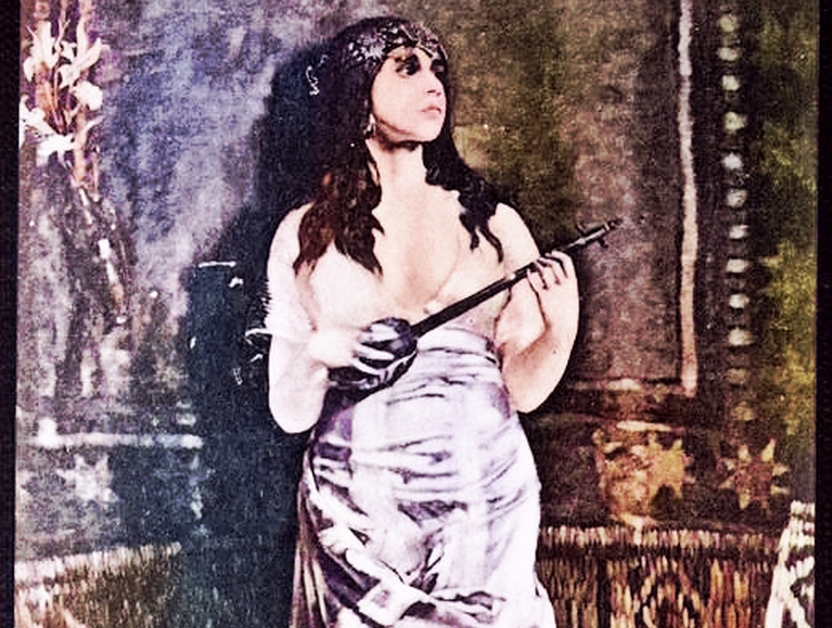Benzion Dinur (1884 Khorol – 1973 Jerusalem) was a famous historian, educator, Zionist activist, and Israeli Knesset member (on the Mapai party’s list, 1949-1951) who served as Minister for Education and Culture (1951-1955), and Israel Prize laurete (twice). Dinur largely contributed to the elaboration of an historical method around the "Palestinocentric" vision of the entire course of the Jewish history (“Jerusalem School”). He was a pupil of the Telsh and Slobodka yeshivot, and studied at the Universities of Berlin (1911-1913), Bern (1913-1915) and Petrograd (1915-1917). Benzion Dinur taught in several Jewish schools in the Russian Empire, was very active in the Society for the Promotion of Enlightenment among the Jews in Russia (OPE), and in the Zionist Socialist Workers Party in Russia. In 1921, with a group of Hebrew writers, Dinur received an exit permit from the Soviet authorities, and settled in Palestine. Soon thereafter he joined the Jewish Teachers' Training College in Jerusalem as a teacher and later became its headmaster (1943-1948). In 1936 he was appointed lecturer in modern Jewish history at the Hebrew University. Benzion Dinur was among the founders and editors of the bibliographical quarterly Kirjath Sepher, the historical annual (later quarterly) Zion and of other historiographical projects related to Jewish history, Zionism and the Yishuv. Dinur served as the chairman of the Jewish Historical General Archives (later the Central Archives for the History of the Jewish People). He was one of the central figures in the Israel Historical Society, and from 1953 to 1959 served as president of Yad Vashem. Benzion Dinur’s private collection comprises of materials related to his life, scholarly and public work in different periods and places. The collection contains Dinur’s extensive correspondence, his diary, photos and various personal documents. An important part of the collection are records related to Dinur's scholarly and education activities. These include drafts of his articles, books and lectures, notebooks with lesson plans, bibliographies of what he composed, notes, work reports, reviews on various works and books, copies and translations of historical sources used by Dinur. The collection also contains internal documents of numerous institutions with which he worked - including summaries and minutes of meetings (Israeli Historical Society; The Jewish Historical General Archives - later CAHJP; Yad Vashem; Jewish Teachers' Training College in Jerusalem; the Hebrew University; Knesset Education Committee; The Government of Israel and more). The collection also includes many clippings from press and magazines with articles about Dinur, his articles, and on the subject of Zionism --

| Title |
Dinur, Benzion. |
|---|---|
| Contributors |
Dinur Yehoshua Menahem Mendel,Schneersohn 1789-1866 Hayyim Nahman,Bialik 1873-1934 Abraham,Mapu 1808-1867 SamuelEttinger S. N.Eisenstadt (Shmuel Noah), 1923-2010 Salo W.Baron (Salo Wittmayer), 1895-1989 Jacob,Lestschinsky 1876-1966 Joseph,Klausner 1874-1958 Nathan,Rotenstreich 1914-1993 David,Ben-Gurion 1886-1973 Hochschule für die Wissenschaft des Judentums (Berlin, Germany) Mifleget poʻale Erets Yiśraʼel (Political party) Israel. Miśrad ha-ḥinukh ṿeha-tarbut Yeshivat Ṭelz Obshchestvo dli︠a︡ rasprostr. prosv. mezhdu evrei︠a︡mi v Rossīi Tsiyonisṭish-sotsyalisṭishe arbayṭer parṭey (Soviet Union) ha-Mikhlalah le-ḥinukh ʻal shem Daṿid Yelin (Jerusalem) Hebrew University of Jerusalem ha-Arkhiyon ha-kelali le-toldot Yiśraʼel Central Archives for the History of the Jewish People ha-Ḥevrah ha-hisṭorit ha-Yiśreʼelit Yad ṿa-shem, rashut ha-zikaron la-Shoʼah ṿela-gevurah Israel. Keneset Devir (Firm) Mosad Byaliḳ Makhon le-tatslume kitve-ha-yad ha-ʻIvriyim (Jerusalem) Hekhal ha-sefer (Jerusalem) ha-Arkhiyon ha-Tsiyoni ha-merkazi Muzeon Zahal Yivo Institute for Jewish Research Yad Yitsḥaḳ Ben-Tsevi World Union of Jewish Studies ha-Aḳademyah ha-leʼumit ha-Yiśreʼelit le-madaʻim ha-Histadrut ha-kelalit shel ha-ʻovdim be-Erets-Yiśraʼel Histadrut ha-morim be-Yiśraʼel Moʻatsah le-haśkalah gevohah (Israel) |
| Notes |
The Central Archives for the History of the Jewish People also holds the archives of the Israeli Historical Society, which for decades was headed by Dinur, as well as archives of other prominent historians who corresponded with him, such as Baer, Halperin, and Ettinger. The CAHJP also holds copies of Benzion Dinur's correspondence with Soviet authorities in Belarus and Ukraine as Yad Vashem’s director. The correspondence concerns Dinur's requests of 1957 to send to Israel the remains of Jews who were murdered during the Holocaust and symbolic ashes from the mass graves of the Jews (RU-1866 RU-1915 RU-1916) (originals of the letters located at the National Archives of Belarus and Central State Archives of Public Organizations of Ukraine). In addition, papers of Benzion Dinur's are located in The National Library of Israel: the card catalog of press and bibliography composed by Dinur (ARC. 4* 1507) letters by Dinur to Martin Buber from 1953-1961 on the World Union of Jewish Studies (ARC. Ms. Var. 350 008 178b) correspondence with Gershom Scholem from 1951-1971 (ARC. 4* 1599 01 580) correspondence with Abraham Shalom Yahuda from 1912 (ARC. Ms. Var. Yah 38 01 641) and correspondence with Avraham Ben Mordechai Kahana from 1924-1930 (ARC. 4* 1569 1 170). The Gnazim Archive of the Hebrew Writers Association also contains correspondence of Benzion Dinur with various figures including Shlomo Zemach, Yohanan Twersky, Rivka Alper, Benjamin Brenner and others. |
| Host Item |
Dinur, Benzion - Private Collection |
| Level of Description |
Fonds Record |
| Biographical summary |
Benzion Dinur (Dinaburg) was born in 1884 in Khorol – a small town in the Ukrainian province of Poltava (then, part of the Russian Empire). Dinur’s great-grandfather was the rabbi of Poltava, of Khorol, and a follower of Rebbe Mendel of Lubavitch. He was a pupil of the Telsh and Slobodka yeshivot, and in 1911 entered the "Hochschule fuer die Wissenschaft des Judentums" in Berlin. He also studied at the Universities of Berlin (1911-1913), Berne (1913-1915) and Petrograd (1915-1917). In Russia, he taught in several Jewish schools in Priluki (1902-1903), Odessa (1904), Poltava (1908-1909), Kherson (1910-1911), Petrograd (1916-1918), Kiev (1918-1920). In 1920-1921 he was a lecturer at the University of Odessa. In Russia, Benzion Dinur was also very active in communal affairs and Jewish political life particularly in connection with the Society for the Promotion of Enlightenment among the Jews (OPE), and Zionist Socialist Workers Party. He was the head of the party's regional committee in Kiev (1906) and Kharkov (1907). In 1921, with a group of Hebrew writers, Dinur received an exit permit from the Soviet authorities, and settled in Palestine. Soon thereafter he joined the Jewish Teachers' Training College in Jerusalem as a teacher and later became its principal. In 1936 he was appointed lecturer in modern Jewish history at the Hebrew University. In his numerous historical works Dinur largely contributed to the elaboration of an historical method around a "Palestinocentric" vision of the entire course of the Jewish history (“Jerusalem School”). He stressed the national value of the Jewish communal presence in Eretz Israel over the generations. One of his major historical works was Toledot Yisrael (A History of the Jewish People, 1919–1939) into two sections: Yisrael be-Arso (Israel in Its Country) and Yisrael ba-Golah (Israel in the Dispersion). Dinur was among the founders and editors of the bibliographical quarterly Kirjath Sepher, the historical annual (later quarterly) Zion, the Sefer ha-Yishuv (2 vols., 1939–44), Sefer ha-Ẓiyyonut (1938, 1954), Toledot ha-Hagganah (1954–59), and more. He was one of the central figures in the Israeli Historical Society and the Jewish Historical General Archives (later the Central Archives for the History of the Jewish People), and from 1953 to 1959 served as president of Yad Vashem. In 1949, Dinur was elected to the first Knesset on the Maipai party list, and he served as Minister for Education and Culture from 1951 to 1955. In 1958 he was awarded the Israel Prize in Jewish studies, and in 1973 the prize in education. He died in Jerusalem in 1973. |
| Ownership history |
Transferred by Benzion Dinur to the archives mainly in 1960, 1968 and 1970. |
| Language Note |
Russian Yiddish Hebrew French German English |
| Credits |
הסדרה העוסקת בפעילותו של דינור כח"כ ושר בממשלות ישראל עברה תהליך חשיפה באמצעות ארכיון המדינה. מרבית התיקים באוסף פתוחים לעיון באופן מלא, ושני תיקים ניתנים לעיון רק כעותק דיגיטלי, שעבר השחרה בחלקו. |
| National Library system number |
990043213600205171 |
| Links |
פרטים על מיקום החומר/Location&access |
-
-
-
-
-
-
-
-
-
-
-
-
-
-
-
-
-
-
-
- Show Next 10 Items out of 480
- Show All
-
-
When using this material, please acknowledge the source of the material as follows:
הסדרה העוסקת בפעילותו של דינור כח"כ ושר בממשלות ישראל עברה תהליך חשיפה באמצעות ארכיון המדינה. מרבית התיקים באוסף פתוחים לעיון באופן מלא, ושני תיקים ניתנים לעיון רק כעותק דיגיטלי, שעבר השחרה בחלקו.
תנאי השימוש:
Appropriate Conditions of Use Have Been Established for Every Archive File
The terms of use appear on the archival file page on the National Library website.
For more information about the copyright status inquiry service and terms of use for items from the Library’s collections, click here.
MARC RECORDS
Have more information? Found a mistake?

 Sign in with Google
Sign in with Google
 Sign in with Facebook
Sign in with Facebook



